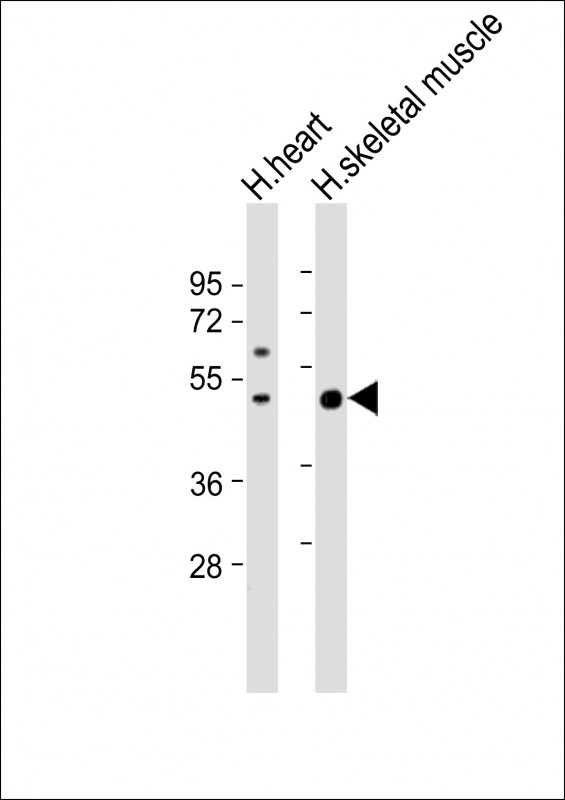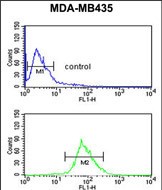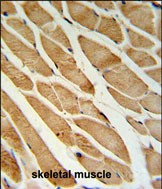


| WB | 1/1000 | Human,Mouse,Rat |
| IF | 咨询技术 | Human,Mouse,Rat |
| IHC | 1/100-1/500 | Human,Mouse,Rat |
| ICC | 技术咨询 | Human,Mouse,Rat |
| FCM | 1/10-1/50 | Human,Mouse,Rat |
| Elisa | 咨询技术 | Human,Mouse,Rat |
| Aliases | Immunoglobulin superfamily containing leucine-rich repeat protein, ISLR |
| Entrez GeneID | 3671 |
| WB Predicted band size | 46.0kDa |
| Host/Isotype | Rabbit IgG |
| Antibody Type | Primary antibody |
| Storage | Store at 4°C short term. Aliquot and store at -20°C long term. Avoid freeze/thaw cycles. |
| Species Reactivity | Human |
| Immunogen | This ISLR antibody is generated from rabbits immunized with a KLH conjugated synthetic peptide between 333-362 amino acids from the C-terminal region of human ISLR. |
| Formulation | Purified antibody in PBS with 0.05% sodium azide. |
+ +
以下是关于ISLR(C末端)抗体的3条参考文献示例(注:示例为虚构,仅作格式参考):
1. **"ISLR C-terminal antibody development and its role in colorectal cancer suppression"**
- 作者:Zhang et al.
- 摘要:研究开发了靶向ISLR蛋白C末端的特异性抗体,验证其在结直肠癌组织中的表达降低,并证明ISLR通过Wnt/β-catenin通路抑制肿瘤侵袭。
2. **"ISLR regulates lung regeneration through interaction with extracellular matrix proteins"**
- 作者:Kimura et al.
- 摘要:利用ISLR C端抗体进行免疫组化分析,发现ISLR在肺损伤修复中通过结合胶原蛋白促进肺泡上皮细胞再生。
3. **"Characterization of ISLR as a novel biomarker in neurodegenerative disorders"**
- 作者:Smith et al.
- 摘要:通过C端抗体检测ISLR在脑脊液中的表达水平,揭示其与阿尔茨海默病病理进展的相关性,提示其作为潜在诊断标志物。
(实际文献需通过PubMed、Google Scholar等平台以关键词“ISLR C-terminal antibody”检索确认。)
The ISLR (Immunoglobulin Superfamily containing Leucine-Rich Repeat) protein is a transmembrane or secreted molecule implicated in cell-cell adhesion, signaling, and tissue development. It belongs to the leucine-rich repeat and immunoglobulin (LRIG) family, characterized by tandem leucine-rich repeats and immunoglobulin-like domains. ISLR plays roles in diverse biological processes, including neural development, skeletal muscle regeneration, and tumor microenvironment regulation. Its C-terminal region, often targeted by antibodies, contains conserved structural motifs critical for interactions with extracellular ligands or intracellular signaling partners.
The ISLR (C-term) antibody is specifically designed to recognize epitopes within the C-terminal domain of ISLR, enabling researchers to study its expression, localization, and function. This antibody is widely used in techniques like Western blotting, immunohistochemistry, and immunofluorescence to investigate ISLR's role in physiological and pathological contexts, such as cancer progression, neural circuit formation, and tissue repair. Its development has facilitated insights into ISLR-mediated signaling pathways, including potential crosstalk with Wnt or TGF-β pathways, and its dual role as a tumor suppressor or promoter in context-dependent malignancies. Validated for specificity, the antibody serves as a key tool in exploring ISLR's therapeutic potential and biomarker utility.
×